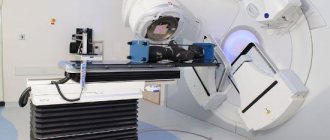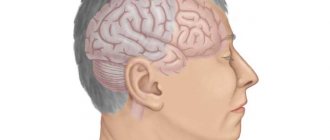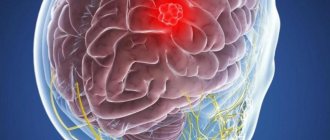Order on Aliexpress with delivery from Russia and up to 25% discount
Spinal cord edema, like any type of edema, is an excessive accumulation of fluid, but in this case a rather important part of the body suffers. The problem concerns not only tissues (cells), but also the intercellular space. If you ignore treatment, this can threaten you with more than one complication, impaired immunity and blood circulation, motor dysfunction - this is only part of what can happen with swelling of the spinal cord.
Spinal cord edema has several forms of development, which are divided depending on the root cause of the disease. It is worth saying right away that such a problem is only a consequence of other pathological diseases, and not an independent disease. If we consider swelling of the spinal cord of the spine, what it is, then we can distinguish 3 main groups, which differ in nature:
- Cytotoxic spinal cord edema. Most often, this problem occurs after various physical injuries to the spine. The flow of oxygen and blood is disrupted, and hypoxia causes a number of chemical reactions that disrupt metabolism in the intervertebral region. Sodium begins to accumulate (which, as is known, has the strongest function of accumulating liquid). If you ignore this problem, then over time astrocytes will begin to die, causing dysfunction and destruction of neurons. Despite this, timely treatment is extremely effective and after 6-8 hours blood circulation will be restored and the swelling itself will completely subside;
- Interstitial edema of the spinal cord. With such tumors, the patient has hydrocephalus. Cerebrospinal fluid begins to accumulate, in addition, cerebral (intracranial) pressure increases;
- Vasogenic spinal cord edema. It manifests itself when the integrity of the blood-brain barrier (BBB) is disrupted. It serves as a “partition” between the blood and the nervous tissue, which prevents not only the blood cells itself, but also large, polar molecules from entering the brain. In the process, osmotic pressure is disrupted, which disrupts the normal functioning of the BBB - now it allows ions to pass through, and fluid begins to accumulate in the intercellular space. The speed of this process is directly proportional to blood pressure (more pressure means the liquid heats up faster). In this case, swelling of the spinal cord of the spine has much more serious consequences - these are neoplasms and vascular microembolism.
In addition, there is some classification depending on what reason caused the appearance of such edema:
- Traumatic;
- Inflammatory;
- Toxic;
- Ischemic;
- Hypertensive;
- Swelling of the spinal cord after surgery.
Causes of spinal cord edema
As mentioned earlier, the reasons can be very diverse, the list of which includes:
- High blood pressure;
- Internal hemorrhage;
- Intoxication;
- Ischemic condition (heart problems);
- Inflammatory processes;
- Tumors of various origins;
- Infections;
- Physical trauma and other mechanical impacts;
- In acute respiratory failure, ascending edema of the spinal cord can be provoked. In this case, assisted ventilation is necessary.
Causes
There are a number of main reasons leading to spinal cord edema:
- persistent high blood pressure (hypertension);
- spinal injuries;
- osteochondrosis and other diseases of the spine;
- internal bleeding;
- coronary heart disease;
- infection of the body;
- intoxication;
- tumor neoplasms of a malignant and benign nature;
- acute respiratory failure;
- any inflammatory processes.
Symptoms of spinal cord edema
Any such edema has two groups of symptoms:
- Focal. It appears locally, depending on which area is affected (upper limbs, cervical spine, legs, etc.);
- Stem. A narrower range of features.
It is worth considering separately the second subgroup, which includes:
- Poor blood circulation;
- Impaired breathing (frequency and strength);
- Laxity in the coastal muscles;
- Low body temperature, and in some cases, chills;
- Anergy (powerlessness);
- Reduced excitability;
- Loss of sensitivity to tactile contacts, temperature differences, decreased pain perception;
- Intracranial hypertension. It appears as fluid begins to accumulate in the skull. Leads to: severe headache (feeling of fullness from the inside); nausea; vomiting; loss of consciousness.
- Heredity;
- Lymphocytes in the spinal cord.
- The latter is also associated with a complication in the form of spinal shock, when some of the reflex centers located below the edema almost completely lose their functionality. All are accompanied by hypertension (high blood pressure), bradycardia (slow heart rate), partial plegia (paralysis) of the limbs. With this problem, swelling of the spinal cord has unpleasant consequences:
- Low blood pressure;
- Frequent trips to the toilet;
- No vascular reactions.
This condition can occur in a patient from several hours to several weeks.
Types of tumor
The swelling itself manifests itself against the background of not only some kind of illness. To be specific, against the background of the appearance of a tumor, which comes in several types:
- Meningiomas. Formed from the spinal cord membrane itself;
- Schwannoma. Formed from nerve endings.
Malignant neoplasms most often result from mutations of glial cells - astrocytes, microglia and oligodendrogliocytes. Quite rarely, connective tissue begins to mutate. As such a tumor grows, sooner or later it will begin to compress the nerve roots, which causes the main symptoms.
Treatment of spinal cord edema
With a diagnosis such as spinal cord edema, treatment should be carried out exclusively by a doctor. Any attempts to avoid an early visit to him, self-medication, or violation of instructions given by a specialist will lead to serious and, sometimes, irreversible consequences, which include:
- Immune dysfunction;
- Poor blood circulation;
- Breathing problems;
- Disability (failure of limbs);
- A fatal outcome cannot be ruled out.
The treatment itself implies, first of all, getting rid of the root of the problem, be it an infection, tumor, fracture or something else. However, unlike most edema, in this case getting rid of the root of the disease will not be enough. There are several important steps.
Specific therapy
This therapy is carried out to directly reduce the volume of edema and its overall size. Doctors use drugs that can affect a person’s electrolyte balance and, naturally, bring it back to normal. Medicines with this effect include:
The complex also uses drugs that inhibit diuresis and reduce the amount of cerebrospinal fluid synthesized.
For the first purpose use:
And to achieve the second:
Important! Unlike other cases of edema, you should not resort to the independent use of diuretics, this will complicate the recovery process. The dosage of medications is determined individually by the treating specialist after a series of analyzes and tests; it must not be violated under any circumstances.
Pressure recovery
This is the most important part of the entire wellness course. The doctor must restore cerebral perfusion pressure (CPP), because blood circulation and the supply of all necessary substances to neurons depend on it. In this case, the CPP is reduced due to increased intracranial pressure. To fix this problem, resort to:
- Normalization of oxygenation (maintaining the required oxygen level);
- Use of diuretics;
- Elimination of seizures;
- Normalization of body temperature;
- The most important thing is to eliminate the reason why the outflow of fluid from the skull is impaired.
Glucocorticosteroids
Drugs in this category are used to stabilize cell membranes, the endothelium of small vessels, and also to prevent the accumulation of catecholamines. The following medications are used:
Surgery
Surgeries are performed only in severe cases, and most often this is not due to the elimination of edema, but to intracranial pressure that needs to be reduced. In this case, only general anesthesia is used, and not spinal anesthesia.
Remember that problems related to the spinal cord cannot be delayed. This organ controls a considerable part of the reflexes, without which human existence would not be possible. If you suspect such an illness, be sure to consult a doctor.
Spinal cord edema is a process of accumulation of fluid in the intercellular and cellular space, which provokes an increase in the volume of the spinal cord and discomfort. Due to the trapped liquid, the cells move apart, causing oxygen starvation, cell damage and disruption of the exchange between them. This process is also called cell swelling.
Causes and methods of diagnosis
Medicine does not have clearly defined reasons for the development of the disease. These may be genetic disorders and the effects of radiation, chemical production, increased amounts of ultraviolet radiation, as well as poor diet and bad habits. The main provoking factors for the appearance of swelling:
- brain injuries from a bruise, fall or blow to the back;
- infectious diseases and inflammatory processes;
- osteochondrosis;
- degenerative changes in the vertebrae;
- tumors of various etiologies;
- herniated discs;
- high blood pressure;
- diseases of the cardiovascular system;
- acute respiratory failure.
People suffering from endocrine disorders and metabolic disorders are predisposed to the appearance of edema.
During diagnosis, the doctor visually examines the spine. If a predisposing factor is detected, the doctor may suspect an accumulation of exudate in the spinal cord. Additional research and analyzes are needed to confirm suspicions.
The most informative are:
- radiography in several projections to detect existing spinal diseases;
- three-dimensional CT image allows you to detect even minor changes in the vertebrae;
- MRI makes it possible to recognize the location of the edema, its size and severity of the condition.
The patient is given a blood test for rheumatic complex and tests for tumor markers. If oncology is suspected, biological material is collected followed by histology.
Types of edema
There are several different forms of swelling, which differ in the causes of occurrence and pathological features of the course of the disease. During the study, swelling was divided into forms depending on the mechanism of its occurrence:
- cytotoxic species;
- vasogenic;
- interstitial.
The first type occurs due to trauma and physical damage to the brain, which are manifested by hypoxia and a failure in the metabolic process. Typically, after damage, sodium accumulates in the cells, causing fluid to accumulate in the tissues. Further along the chain, swelling approaches the astrocytes located in close proximity to the vessels and kills all nearby cellular forms.
The second form of swelling occurs due to the osmotic pressure of ions. The cellular barrier becomes weak and allows positively charged ions to pass through, which are a provoking factor in the process of fluid formation in the cells and the space between them. Typically, this type of process occurs when there is a tumor in the brain, blockage of blood vessels, or problems with the carotid arteries. All edematous processes depend on the level of blood pressure: the higher it is, the faster the process of fluid accumulation.
This form is the most common among patients, so diagnosing it and prescribing treatment will be the easiest.
The third form, interstitial edema, is caused by a pathological disease characterized by an increase in the amount of cerebrospinal fluid in the cranial cavity. At the same time, the level of intracranial pressure increases, which provokes even greater accumulation of excess water in the tissues.
Description
Spinal cord edema has several forms of development, which are divided depending on the root cause of the disease. It is worth saying right away that such a problem is only a consequence of other pathological diseases, and not an independent disease. If we consider swelling of the spinal cord of the spine, what it is, then we can distinguish 3 main groups, which differ in nature:
- Cytotoxic spinal cord edema. Most often, this problem occurs after various physical injuries to the spine. The flow of oxygen and blood is disrupted, and hypoxia causes a number of chemical reactions that disrupt metabolism in the intervertebral region. Sodium begins to accumulate (which, as is known, has the strongest function of accumulating liquid). If you ignore this problem, then over time astrocytes will begin to die, causing dysfunction and destruction of neurons. Despite this, timely treatment is extremely effective and after 6-8 hours blood circulation will be restored and the swelling itself will completely subside;
- Interstitial edema of the spinal cord. With such tumors, the patient has hydrocephalus. Cerebrospinal fluid begins to accumulate, in addition, cerebral (intracranial) pressure increases;
- Vasogenic spinal cord edema. It manifests itself when the integrity of the blood-brain barrier (BBB) is disrupted. It serves as a “partition” between the blood and the nervous tissue, which prevents not only the blood cells itself, but also large, polar molecules from entering the brain. In the process, osmotic pressure is disrupted, which disrupts the normal functioning of the BBB - now it allows ions to pass through, and fluid begins to accumulate in the intercellular space. The speed of this process is directly proportional to blood pressure (more pressure means the liquid heats up faster). In this case, swelling of the spinal cord of the spine has much more serious consequences - these are neoplasms and vascular microembolism.
In addition, there is some classification depending on what reason caused the appearance of such edema:
- Traumatic;
- Inflammatory;
- Toxic;
- Ischemic;
- Hypertensive;
- Swelling of the spinal cord after surgery.
Symptoms
The consequences of ACM can be unpredictable if treatment is not started in a timely manner. Therefore, at the first manifestations, it is important not to hesitate, but to seek qualified help.
Symptoms accompanying swelling can be of two different types: stem and focal.
The latter are expressed by a violation of the functionality of the body system or organ directly at the site of localization.
Stem symptoms manifest themselves in the following signs:
- poor blood circulation;
- loss of sensitivity to tactile contact, lack of temperature sensations and pain sensitivity;
- low body temperature, which may be accompanied by chills;
- changes in breathing and its frequency;
- decreased reflex functions and reactions to external light and sound stimuli;
- lethargy in the muscles of the limbs;
- cardiac arrhythmia, heart rhythm disturbance;
- decreased excitability, lethargy, anergy.
Symptoms
Pain in the vertebrae can be attributed to almost any ailment of the musculoskeletal system, which in turn makes it difficult to make a diagnosis. But without timely consultation with a doctor, there is a risk of death, especially if there is swelling of the cervical spine, which is the most dangerous.
The pathological process is accompanied by the following symptoms:
- Impaired functioning of the respiratory system.
- Decreased vision.
- Neurological disorders.
- Irregularities in heart rhythm.
- Paralysis of the upper or lower limbs.
- Acute pain in the back, in the affected area.
- Disruption of the senses.
- Dysfunction of the pelvic organs (problems with urination or bowel movements, constipation, bladder pain).
- Loss of skin sensitivity.
- Cramps and spasms in the legs or arms.
Pain syndrome can be observed not at the location of the pathology, but several centimeters higher, this is explained by the accumulation of a large amount of fluid and compression of the nerve endings. When the cervical spine is affected, the pressure inside the skull increases, hydrocephalus appears, and nerves are pinched.
Patients with bone marrow edema often develop allergies, exacerbation of radiculitis or intestinal infections. This occurs due to a sharp decrease in the body’s immunity due to the appearance of pathology.
Diagnostic tests
If there is a malignant tumor in the human body and complaints of pain in the back, which intensifies during movements or palpation, weakness and impaired coordination of actions, the doctor may suspect a spinal cord tumor.
Violation of certain functions can easily indicate the location of the tumor. To connect discomfort, pain and neoplasm, it is necessary to exclude other pathological processes with similar symptoms: poor blood supply, fractures or other injuries of the spine or discs, displacements or pinching caused by viral infections, inflammatory processes in the muscles, blood disease.
Using MRI data, the exact localization of the formation, size, and volume are determined. A biopsy will help analyze the species and predict possible consequences for a person.
The first thing to do in treatment is to eliminate the cause of the swelling in order to relieve the load on the vertebra. It must be taken into account that various kinds of influences and changes will not end there.
With the help of specific treatment, the volume and size of edema can be reduced. To do this, they use drugs that can affect the electrolyte balance and normalize it. These drugs include Veroshpiron and Brinaldix. In combination with them, pharmaceutical drugs are used that reduce the production of cerebrospinal fluid, as well as inhibit diuresis. In order to avoid even greater complications in treatment, it is undesirable to use osmotic diuretics, as well as vasodilators.
The following drugs, which are used for edema, are substances that normalize the condition of cell membranes and act as preventative agents for lysosomal pathologies in the cells of the damaged brain. Typically, glucocorticosteroid medications are used in this case.
Painkillers, nootropic and anti-inflammatory drugs that help quickly relieve swelling and eliminate pain syndromes.
During rehabilitation, the doctor may prescribe a course of vitamins and microelements to restore lost immunity, normalize metabolism, improve blood circulation and enrich cells with oxygen.
For paralysis, muscle relaxants such as Tubocurarine are used.
Particularly complex and advanced processes are solved surgically, when alternative medicine methods are powerless in the fight to reduce swelling and restore cells. During the operation, spinal anesthesia is used.
Symptoms of salt deposits in the spine
Salt deposition - osteochondrosis - tends to develop gradually and imperceptibly. This is caused by a person’s attitude towards the disease - until the symptoms limit life, people do not pay attention to it. So, in this case, the first signs of the disease appear quite early, which makes it possible to prevent the development of permanent changes.
At first, symptoms occur only with excessive load - they indicate small changes in the intervertebral cartilage. But they progress over time, gaining strength and appearing at rest:
- A crunch in the back with various bends and turns of the body indicates slight changes in the joints. There are still no signs of salt deposition - there is only excess mobility in individual vertebrae. In the early stages, this phenomenon occurs only with sudden movements.
- Then comes discomfort in the area of the affected spine. There is a feeling of heaviness in the back of the neck, between the shoulder blades or in the lower back. They intensify with prolonged and monotonous body position, for example, after work.
- The disease has already progressed if the crunching in the affected area is accompanied by pain. Any awkward movement leads to unpleasant symptoms, which is caused by active ossification of soft tissues.
- The outcome is impaired mobility in the back - it is no longer possible to bend over or lean to the side. Any attempt to make such movements ends in an attack of nagging pain. Posture is impaired, which leads to stooping.
In the first stages, the deposition of salts in the back can be stopped, which can only be done with the help of a doctor - he will give you the necessary recommendations.
Preventive measures, possible consequences
Pathological consequences and various kinds of changes can affect any life-supporting system of the body, any organ. Therefore, a mandatory requirement for a healthy body is preventive measures that help avoid complications and unpleasant diseases. A bedridden patient must be protected from encountering troubles, and therefore it is important to provide artificial urine output and regular body treatment to protect against bedsores. Breathing exercises will help keep the systems in working order, and physical development of the limbs, massage and other physiotherapeutic complexes will prevent the muscles from losing tone, atrophying and losing strength. Rehabilitation centers contain ready-made programs for the rehabilitation of such diseases.
Spinal cord edema is a pathological condition of accumulation of excess fluid in the intercellular space and cells of the spinal cord. As a result, the volume of the brain increases.
Cerebral edema is not a separate disease, but a concomitant symptom of other diseases.
Classification
There is a classification of types of edema:
- due to the reasons for its appearance, edema can be tumoral, toxic, hypertensive, traumatic, inflammatory, ischemic;
- According to pathogenesis, it is divided into cytotoxic and vasogenic.
Cytotoxic edema is a consequence of metabolic and toxic damage within cells. Due to the deterioration of metabolic processes, the functionality of the membrane (shell) is disrupted, sodium and, subsequently, liquid begin to accumulate.
This swelling is reversible - provided that normal blood circulation is completely restored, it subsides within 6-8 hours.
Vasogenic edema - disorders are both intra- and extracellular in nature. Its cause is damage to the permeability of the blood-brain barrier and the release of plasma components into the extracellular space. This helps to increase filtration and water accumulation.
This type of edema is called vascular edema because water leaks out of capillaries and other small vessels when blood flow slows down. The development of vasogenic edema plays a large part in the compression of the white matter of the spinal cord.
- tumors of any etiology;
- increased blood pressure;
- spinal cord injuries (fracture, rupture of intervertebral discs, compression, concussion, bruise);
- inflammatory processes;
- infectious lesions (abscess in the area of the meninges);
- hemorrhages;
- general infections of the body that do not directly affect the spinal cord; poisoning;
- ischemic conditions;
Common to all types of edema, they are divided into two groups: focal and stem.
Focal symptoms appear when swelling is localized in a specific area of the spinal cord. In this case, the functions of this area are disrupted.
Stem symptoms are manifested by impaired blood circulation and breathing, decreased pupillary response.
Spinal shock may develop. Then there is a sharp decline in excitability, a decrease in the functionality of all reflex centers of the spinal cord located below the site of edema. They do not respond to stimuli and do not act. Pain, temperature, tactile and proprioceptive sensitivity disappears.
A characteristic sign of shock is flaccid plegia of the limbs. Hypothermia and bradycardia develop.
The consequences of shock are acts of urination and defecation, a drop in blood pressure, and the absence of vascular reactions. The duration of the shock can range from several hours to several weeks.
With such a serious condition as spinal cord edema, symptoms can be varied, often protracted.
First of all, eliminate the cause of the swelling. It should be taken into account that morphological and physiological changes do not stop after the end of exposure to the traumatic factor.
Specific treatment is aimed mainly at reducing the amount of edema. This is achieved by using drugs that normalize electrolyte balance (Brinaldix, Veroshpiron), drugs for forced diuresis (Lasix, Furosemide), drugs that reduce the production of CSF (Diacarb, Acetazolamide). You should not use osmotic diuretics (Mannitol), because there is a high probability of “recoil” symptoms.
The use of glucocorticosteroids (Dexamethasone, Hydrocortisone, Dexaven, Cortef). The dosage depends on the severity of symptoms - 8 - 20 mg per day. These drugs stabilize cell membranes, the endothelium of small vessels, preventing the accumulation of catecholamines and lysosomal disorders in the cells of the damaged brain.
The use of nootropic agents as membrane protectors. These include Vinpotropil, Gammalon, Lucetam, Nootropil, Piracetam.
Rheologically active agents (Trental, Reopoliglyukin, Kurantil) improve microcirculation, reduce hypoxia and edema, and maintain the hematocrit level in the region of 30 - 35%.
The use of hyperbaric oxygen therapy increases oxygen pressure into the cells and tissues of the spinal cord and improves blood flow to the affected areas.
Some clinics use lidocaine, dopamine, barbiturates, and hyaluronidases to suppress auto-destructive processes.
Vitamins - Cyanocobalamin, Thiamine, Pyridoxine, Ascorbic acid - normalize metabolism, improve blood circulation in capillaries , and as a result, increase the transport of oxygen and nutrients to brain tissue.
For paralysis, muscle relaxants (Pancuronium, Tubocurarine, Metokurine) will be used.
You cannot use vasodilators (Dibazol, Nitroglycerin), calcium ion antagonists, drugs such as Aminazine, Reserpine, Droperidol.
Spinal Injury Clinic
The clinical picture of spinal cord injury consists of symptoms of traumatic spinal injuries and symptoms of spinal cord injury, which are combined in varying proportions. In this case, there is no parallelism between the degree of spinal damage and the severity of spinal cord damage. Damage to the ligamentous apparatus and dislocations of the vertebrae are characterized by limited mobility, severe pain on palpation of the spine, and the appearance of a forced position of the torso. They can occur without disruption of the spinal cord functions. In case of vertebral fractures, deformation (curvature) of the spine is observed, protrusion of the spinous process at the fracture site, local pain when pressing on it, muscle tension in the form of ridges on both sides of the spinous processes of the damaged vertebra - “symptom of the reins” (L.Ya. Silin, 1990) . The severity of spinal cord injury, especially in the early stages after injury, is largely determined by the development of spinal shock. Spinal shock in the first hours, days, and sometimes weeks after injury can cause the clinical picture of the so-called “physiological” transverse break of the spinal cord. Spinal shock is a pathophysiological condition characterized by disturbances in the motor, sensory, and reflex functions of the spinal cord below the level of damage. In this case, there is a loss of active movements, a decrease in muscle tone, sensitivity and functions of the pelvic organs are impaired, a decrease in skin temperature, and sweating disorders are noted. The presence of constant irritants (bone fragments, foreign bodies, hematomas) can maintain the phenomena of spinal shock for a long time. According to the clinical course, the following types of traumatic injuries of the spinal cord are distinguished: 1. Concussion of the spinal cord is the mildest form of injury. Pathophysiological is characterized mainly by reversible functional changes in the spinal cord. Clinically, a concussion of the spinal cord is manifested by transient symptoms of dysfunction of the segmental apparatus of the spinal cord in the form of a decrease or loss of tendon reflexes, hypo-or anesthesia, and less often and less - dysfunction of the conductive tracts. These symptoms are unstable and usually disappear within 1-7 days after the injury. With lumbar puncture, the cerebrospinal fluid is unchanged, the patency of the cerebrospinal fluid space is not impaired. 2. Spinal cord contusion is a severe form of spinal cord injury, in which, along with organic changes in the brain in the form of hemorrhages, edema, and separation of individual areas, partial or complete disruption of the conductivity of the spinal cord is characteristic. Clinically, when the spinal cord is killed, disturbances of all its functions are observed in the form of paralysis with muscle hypotonia and areflexia, sensitivity disorders and dysfunction of the pelvic organs. When the spinal cord is killed, the cerebrospinal fluid is usually bloody; there are no liquorodynamic disturbances. After the disappearance of the phenomena of spinal shock, a gradual (within 2-3 weeks) restoration of lost functions occurs. First, tendon reflexes are restored and pathological reflexes appear, a decrease in muscle tone changes to a spastic state. Anesthesia is modified by hypoesthesia with a lowering of the upper limit of sensitivity impairment, and the functions of the pelvic organs are gradually normalized. The degree of dysfunction depends on the severity of the spinal cord obstruction. In severe cases of slaughter, restoration of lost functions is usually incomplete. 3. Compression of the spinal cord is often combined with its destruction, sometimes with its release. Compression of the spinal cord can be the result of: displacement of fragments of the arches or vertebral bodies into the spinal canal; protrusion into the spinal canal of the yellow ligament or disc; presence of foreign bodies - in case of open damage; formation of hematomas of various locations. A combination of these factors is possible. The compression syndrome is deepened by concomitant disorders of hemo- and liquor circulation, edema - swelling of the brain. Compression syndrome is characterized by an acute onset, less often - a gradual increase in motor and sensory disturbances after injury - until a complete disruption of the conductivity of the spinal cord. When an epidural hematoma forms, radicular pain in combination with conduction disturbances is characteristic; a phased course is possible in the form of a short-term “light” interval with the following picture of increasing compression of the spinal cord. Auxiliary examination methods are decisive in determining spinal cord compression. Lumbar puncture with liquor-dynamic tests often reveals partial or complete cerebrospinal fluid blockage of the subarachnoid space, radiography of the spine, computed tomography or magnetic resonance imaging - narrowing of the spinal canal at the level of damage. 4. Disintegration of the spinal cord can lead to partial or complete anatomical interruption of the spinal cord (tear, rupture of the spinal cord) with severe motor and sensory disturbances, and dysfunction of the pelvic organs. The prognostic degree of functional recovery correlates with the degree of anatomical damage. 5. Hematomyelia. Spinal cord injury can lead to hemorrhage into the gray matter of the spinal cord - hematomyelia. Spreading through the central canal, the blood destroys the gray matter and compresses the pathways. According to the level of hematomyelia, motor disturbances are sluggish in nature, sensory disturbances acquire a dissociated form - weakening (or loss) of pain or temperature sensitivity while maintaining tactile sensitivity. Sweating disorders of the segmental type are possible. Lumbar puncture with CSF tests, as a rule, does not reveal any changes. 6. With certain types of spinal cord injury, damage to the roots of the spinal cord is possible - destruction with intra-stem hemorrhage, stretching, compression (partial or complete), separation of one or more roots from the spinal cord. Clinically, according to the affected area, sensory disturbances, peripheral paresis or paralysis, and autonomic disorders are revealed. The main criteria for determining the level of traumatic injury to the spinal cord are the area of sensory impairment, radicular pain and the level of loss of reflexes, movement disorders and dysfunction of the pelvic organs. Each part of the spinal cord has its own clinical features. With traumatic injury to the spinal cord at the level of the upper cervical region (CI-CIV), tetraplegia of the central type develops with the loss of all types of sensitivity below the level of injury, paralysis of the neck muscles of the peripheral type. A serious complication of damage at this level is the development of ascending edema of the brain stem with disruption of its functions (impaired breathing, swallowing, cardiovascular activity). With traumatic damage to the middle cervical segments (CV-CV) at the level of the origin of the phrenic nerve, the above symptoms are accompanied by disturbances in diaphragmatic breathing. With traumatic lesions of the lower cervical segments (CV-CVIII) and the first thoracic segments involved in the innervation of the upper limb, symptoms of damage to the brachial plexus are characteristic. In this case (level CVIII-TI), damage to the ciliary-spinal center is possible, sympathetic innervation of the eye is disrupted with the development of one- or two-sided Horner's syndrome (ptosis, miosis, enophthalmos). Lesions across the diameter of the spinal cord are characterized by lower spastic paraplegia, conduction-type sensory impairment corresponding to the affected segment, and trophoparalytic syndrome. Traumatic lesions of the thoracic spinal cord are characterized by lower spastic paraplegia, shallow breathing with atrophic paralysis of the muscles of the back and chest, disappearance of abdominal reflexes, dysfunction of the pelvic organs of the central type. Based on the level of sensitivity impairment, the level of spinal cord damage can be determined: TIV - nipple level, TVII - costal arches, TC - at the level of the navel, TCII - at the level of the inguinal ligament. If damage occurs at the level of the lumbar enlargement (Li-SII), paralysis of the lower extremities of the peripheral type develops with the absence of reflexes and muscle atony, all types of sensitivity below the Pupart ligament are lost, and the function of the pelvic organs is impaired. A lesion at the level of the conus medullaris (SIII-SV) is characteristic of injury to the I-II lumbar vertebrae, with all types of sensitivity in the perineum and genital area (in the shape of a saddle) lost, and atrophy of the gluteal muscles develops. Characteristic dysfunction of the pelvic organs is of a peripheral type - true urinary and fecal incontinence, sexual weakness. Damage to the cauda equina occurs with fractures of the lumbar vertebrae - III-IV. If all elements of the cauda equina are damaged, peripheral paralysis of the lower extremities occurs with sensory disturbances in the form of uneven hypoesthesia in the area of the lower leg, feet, back of the thigh, and buttocks. This is characterized by intense pain with a causal tinge. With traumatic damage to the sacral roots (injuries at the level of the III-V sacral vertebrae), sensitivity is lost with the appearance of pain in the perineum, rectum and genitals, and dysfunction of the pelvic organs of a peripheral type occurs. First aid for traumatic lesions of the spine and spinal cord includes the elimination of respiratory disorders (if necessary - cleansing the oral cavity of foreign bodies, vomit and mucus, to ensure adequate breathing - insertion of an air duct, tracheal intubation), prescription of painkillers (analgin, promedol) and sedatives (Relanium, Seduxen, Diphenhydramine, various mixtures, drops). In case of urinary retention - catheterization of the bladder. Patients with spinal cord injury are transported on a rigid surface (board or special stretcher) with appropriate fixation of the body to specialized neurosurgical departments, and in their absence, to the nearest hospital in the trauma department. The main task of personnel providing medical care at the prehospital stage is to avoid further damage to the spine and spinal cord, prevent deterioration of the patient’s condition during transportation, and prevent and combat secondary changes caused by ischemia and compression of the spinal cord.
Prevention
When spinal cord swelling occurs, the consequences are varied. Changes and disturbances may occur in any part or organ of the body. The ability to restore the functionality of these organs depends on many factors. Rehabilitation after treatment is of great importance.
Prevention is to prevent the development of complications. During bed rest, you need to determine the state of urination and find an adequate method for removing urine. In this case, the rules of antisepsis and asepsis must be observed to avoid infection.
Prevention of bedsores consists of a set of measures - choosing and changing positions, keeping the bed and the patient clean, wiping the skin with an alcohol solution.
Prevention of contractures is carried out by therapeutic exercises and massage, and the use of orthopedic techniques.
Prevention of pulmonary inflammatory complications involves normalizing respiratory functions, inhalations, therapeutic exercises, and vibration massage.
Experts advise not to neglect physiotherapeutic procedures to stimulate recovery processes and therapeutic exercises even after discharge from the hospital.
Spinal or bone marrow edema is a pathology associated with the accumulation of excess fluid in the spine. As a result of this disease, the volume of tissues often increases, and they are no longer able to be in their normal anatomical position without injury.
Aseptic edema
This type of bone marrow edema first develops in the neck or head of the femur. Its presence is determined visually:
- The sore spot turns red;
- Its temperature rises;
- Swelling is clearly visible;
- There are painful sensations.
Small blood vessels in the affected area release exudate of the serous or fibrinous type, or combinations thereof, into the tissue.
Also, swelling can have different localization. Along with the usual, subchondral edema is distinguished, affecting the subchondral (subchondral) plate. Such edema is detected by urine analysis for C-terminal cross-linked telopeptides of type II collagen.
Mechanism of occurrence
The development of edema is always a reaction to any pathological processes occurring in the human body. Edema develops most often if, under the influence of any negative reasons, the bone beams of the vertebrae are destroyed and the blood vessels are damaged. Most often, this is a kind of protective reaction of the body to any external influence.
Traumatization of tissues and blood vessels leads to the development of active local inflammation. It usually occurs without infection, but as a result, exudate is formed, which provokes an increase in tissue volume. Exudate is designed to help tissues adapt to adverse effects, but sometimes there is so much of it that it negatively affects the person’s condition.
For the development of spinal bone marrow edema, it is necessary to be exposed to some pathological causes. There are mainly three types of unfavorable factors that can affect the spinal column. These include:
- Any diseases of an infectious nature, as a result of which pathological agents enter the blood vessels supplying blood to the spinal cord and, damaging the walls of the vessels, provoke a typical inflammatory reaction.
- Various traumatic injuries, especially of the trabecular type (vascular damage occurs with the formation of hemorrhage, due to which the inflammatory process is formed).
- It is possible to develop swelling with tumors that affect the bone or spinal cord, since the tumor always provokes local inflammation where it is located.
- Osteochondrosis, which changes the distribution of load in the spinal column, leads to the formation of hernias, thinning of the vertebral bodies and cartilaginous plates between them, provokes the development of an inflammatory reaction due to disruption of the normal anatomical position of the vertebrae.
Often the cause of the development of spinal bone marrow edema cannot be determined immediately, which makes subsequent treatment quite difficult.
How quickly the clinical picture of edema develops depends on which of the unfavorable factors affects the spinal canal and the spine as a whole. The level of development of pathology also plays an important role. The most severe symptoms are usually those affecting the neck.
When a spinal injury occurs, the picture is clearest because the symptoms can be linked to a recent accident. If the cause is not injury, diagnosing the disease becomes more difficult. It all depends on the severity of a particular symptom.
The doctor should pay attention to:
- problems with the patient's respiratory system;
- various disturbances in the activity of the heart;
- complaints of sudden, causeless deterioration of vision;
- disturbances in the functioning of the limbs;
- the appearance of pain in one or another area of the spinal column;
- problems with the functioning of organs in the pelvic area;
- complaints of cramps in the limbs, numbness and other unpleasant sensations, etc.
Patients with spinal injuries are at greatest risk. Their condition and further prognosis largely depend not only on treatment, but also on the characteristics of first aid, as well as on subsequent transportation.
Causes of edema
Fluid begins to accumulate in the bone marrow for a variety of reasons. But determining the etiology is extremely important for choosing the most effective treatment tactics, because both the rate of progression and the nature of tissue damage will differ. The most common prerequisites for the appearance of pathology are:
- Inflammatory process. An infection in the body, regardless of location, can easily reach any place through the blood. The waste products of pathogenic microflora provoke an increase in capillaries in size. The immune system responds appropriately and attacks the infection. The wall of the blood vessels is damaged and swelling occurs in the spinal cord.
- Injury. One of the most common causes of the disease. As a result of injury, fracture or severe bruise, fluid accumulation occurs very rapidly. If help is not provided in time, it can be fatal.
- Osteochondrosis. Degenerative processes in the body gradually destroy cartilage and bone tissue, impair the mobility of the vertebrae, and provoke the appearance of hernias. This, in turn, leads to the body attempting to repair the damaged area, which increases swelling. This is one of the most likely complications of the disease.
- Malignant formations. Sometimes the appearance of a pathological process is explained by a tumor. Computer or magnetic resonance imaging can detect this condition.
Important information! Bone marrow edema can be provoked not only by infections occurring in the spine, but also by any processes in the body that easily “migrate” through the bloodstream.
It is easy to detect clinically only swelling of the bone marrow, which is formed as a result of injury. The person requires immediate help, as the condition progresses rapidly and in most cases, medical workers do not have time to conduct studies to clarify the diagnosis.
Acute pain is one of the characteristic signs; it is observed several centimeters above the lesion itself
Which doctor treats spinal cord swelling?
If the cause of the pathology is injury, then the choice of therapy will fall largely on the traumatologist. It is also possible to connect a vertebrologist. If the cause is an infectious process, then the treatment will be handled by an infectious disease doctor. For tumors of the spinal column that lead to edema, treatment will be carried out by an oncologist. Swelling of the spinal cord of the spine can be a life-threatening condition, and therefore it is possible to involve resuscitators. Also, if it is impossible to evacuate the fluid by natural means, surgical intervention is necessary.
Why does the bone marrow swell?
Bone marrow edema is a condition that develops as a result of injury, infection, or circulatory disorders. The clinic is determined by the affected area. Spinal cord edema is a condition directly related to damage to the spine, which is manifested by pain, impairment of motor and sensory functions.
Bone marrow edema and spinal cord edema, despite the similarity of the name, arise due to different reasons, the resulting clinical symptoms and consequences are completely different, and accordingly, the treatment will have fundamental differences. Therefore, these two large groups of violations should be distinguished and considered separately.
Bone marrow got its name due to the importance of its functions, although it has nothing to do with the nervous system. This substance is located inside bone tissue and performs one of the most important functions in the human body - hematopoietic. Bone marrow is divided into two types: yellow and red.
Another important function of the bone marrow is the preservation of stem cells, unique universal precursors of all types of tissues of the human body. Located inside the bones, the brain is directly involved in the nutrition and growth of the bone. The largest amount of bone marrow is located in the long tubular bones, sternum, and pelvic ring.
Considering the anatomical and functional features of this organ, it becomes clear that bone marrow edema is inextricably linked with a violation of the internal bone structure (trabecular edema), with damage to the joint (usually the knee) or the entire bone (usually the femur or tibia).
Diagnostics
Edema of the spinal and bone marrow is quite difficult to diagnose, since the symptoms are usually masked under the underlying disease that provoked this complication. However, if the doctor has identified changes in the spinal column and a set of symptoms that may accompany swelling, he can continue further diagnostic search.
In diagnostics they use:
- radiography, which helps to identify severely advanced spinal injuries;
- CT, thanks to which it is possible to assess the condition of bone tissue;
- MRI, thanks to which the specific localization of edema, features of its location and other important information are determined.
Treatment of edema is a complex, often complex task. First of all, it is necessary to ensure unloading of the spinal column in the affected area in order to prevent the death of nerve cells. It is also necessary to establish and eliminate the cause of the development of the pathology, since without eliminating the cause, the swelling recurs again in a short time.
Relieve swelling using the following groups of drugs:
- diuretics (thanks to them, excess fluid is removed from the body);
- drugs that affect the properties of the blood (designed to speed up the healing process of damaged areas by increasing their blood supply);
- B vitamins (help restore damaged nerve cells).
The patient is required to be prescribed painkillers. Both NSAIDs and, in particularly severe cases, narcotic analgesics can be used at the discretion of the physician.
Glucocorticosteroids and nootropics are also often considered an important element of therapy. They help stabilize cell membranes, protect them from further damage, and reduce the severity of inflammation.
If it is not possible to relieve swelling with drug therapy, surgical drainage is resorted to. The situation in this case is often complicated by the fact that any wrong action can result in disability for the patient at best, and death at worst.
In addition to addressing the causes of edema and the main symptoms of this condition, it is also important to properly organize symptomatic therapy. If the patient suffers from seizures, then they are not ignored by using anticonvulsants. If breathing is impaired, normal ventilation of the lungs is provided; if there are problems with the heart rhythm, medications are taken to correct it.
Treatment of spinal cord edema in each case is selected strictly individually. The choice of drugs should be made by the attending physician, focusing on the characteristics of the patient, the cause of the disease, and the severity of symptoms.
Clinical picture
circulatory, respiratory disorders,
worsening pupil reaction.
All of these are life-threatening manifestations. We can mention the so-called preliminary syndromes - they include manifestations of the syndrome of intracranial hypertension, which develops against the background of an intense increase in the volume of fluid in the cranial cavity. Considering that the skull is a closed type of space, the fluid pressure on the brain receives all the necessary conditions.
The symptoms of a bone marrow tumor are very serious. This is the most important organ that is part of the hematopoietic system, without which the process of creating new blood cells is impossible. Let us remind you that they automatically die. It can be seen in the spongy substance of bones, and in addition, in the medullary cavities.
The organ promotes immunopoiesis, i.e. for the maturation of cells of the immune system, as well as bone formation. If its condition is normal, it contains a huge number of cells of an undifferentiated, poorly differentiated and immature type, which are usually compared with embryonic cells.
It is not difficult to imagine how important the health of this organ is. Thus, according to certain focal symptoms, the localization of edema in a separate part of the brain is determined, due to the appearance of which malfunctions in the functioning of the affected area appear.
Found an error in the text? Select it and a few more words, press Ctrl Enter
DETAILS: How to treat synovial inflammation of the hip joint
Complications
The consequences of spinal cord edema can vary greatly, from complete restoration of all functions to paralysis and, in some cases, death.
The most common complication of this disease is loss of mobility in the limbs, as well as impaired functioning of the pelvic organs. The damage to certain limbs or organs depends largely on the level of damage to the spinal column. The higher the segment of the spine affected by the disease is located, the higher the likelihood of complete paralysis.










